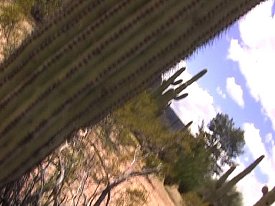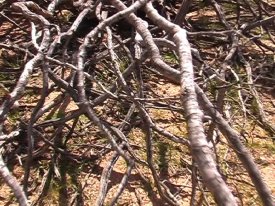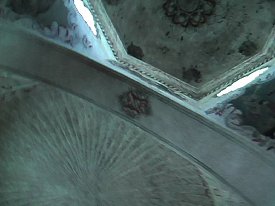
|
 |

|
 |
Scripting with a landscape - Aparna Sharma, Glamorgan e-mail: Aparna31S@netscape.net May 22, 2005 Landscapes assume differing significances and interactions in keeping with sensibilities. They may evoke legend, sanctity, history, political intrigue, environmental insight, aesthetic appeal… and occasionally even a transcendental bond for those with mystical leanings. Landscapes also translate into varying forms of expression. From the mimetic and realistic to the esoteric and abstract - the spectacular, raw and encrusted American Southwest has been articulated variously across media. Smattered with myriad physical formation, and layered with an intricate web of meanings and associations, it lends itself to film posing an uneasy concern before documentary representation, which feels rather innocuous in view of the landscape's enormous and consuming spread. A camera in the landscapes of the south-west Sites in the Arizona and New Mexico are available through the media of varied and contesting anthropological and archaeological interpretation/s. Home to several native Indian settlements, the region is a hotbed of debates surrounding ethnic identity as also environmental controversy. Navigating through this conceptual landscape, I, as a filmmaker, was repeatedly confronted with the dilemma of the territory's numerous and contrary pulls. On the one hand, its colossal and overpowering spread, supplemented by its near primal resonances, mesmeric earthly hues and serpentinean rustic trails, each unfurling an alternative human habitat. On the other hand, the noises of a familiar ‘civilization', with its temples of a malignant ‘global' creed, rigidly linear highways, smitten with an unending habit to restrain and hog. Beyond its natural appeal, the weightage of the American southwest is in the simultaneity of its past and present, struggle and surrender, music and silence.  How does one reconcile the conflicting sounds so arising in a film document? In fact, before that question I ask myself: does a documenting text need to assimilate these sounds, most of which make for no more than noise robbing the landscape of its majestic quietude? Much discussion in contemporary visual anthropology and documentary filmmaking is pregnant, seeking for expression and poetry, without compromising the factual or the found. During the stated field study, the digital video equipment that was utilized met familiar ends, i.e. recording, drafting the interactions and findings of the field study group. But moments were also occasioned when the digital camera and I performed, responding to the sites and materials encountered. In this performance the camera spilled from serving as a means of seeing, to a medium for positions of viewing inaccessible to the lay, human eye. A medium for hearing the commonplace and for picking the distant sounds that often remain inaudible. To an extent, the performance echoed the same sentiment as Soviet filmmaker Dziga Vertov's kino eye1 , back in the 1920s. But it was distinct, as it comprised curvaceous movements for nearness and unity with the subject/s of the image. Camera movement arose, in a sense, corporeally. The camera was hand-held throughout filming. Its movements extended from my body that was mobilised in a kind of dionysian choreographic intercourse with locations and materials. This choreography was rather intimate. Enactment I: A dialogue of movement  Each site - striking and resilient robbed one of all precepts of identity, definition and the conditionings of function and culture. Elemental. Disorderly. Vast. Humble. One could not but walk the uneven soils of the desert bare-feet. And give oneself through touch. Encircling the sparse yet overpowering vegetation. Lining invisible patterns on malleable layers of rock rising high above beaten tracks. And locating miniscule remains of eras from the past, breathing in the present. As our journey traversed in distance, the ecstasy of our encounters, so visually emphatic, propelled a kind of introversion. The further we reached, the more intense the landscape's pull within. This inwardness translated into movement - a drive for touch, nearness and tracings. Seeking inter-action. And oneness with the landscape. Performed by my body. And manifest within the image frame. The camera was the medium for the conversation with the ancient sites, canyons, rivers, rocks and cacti so particular to the South West. Its compactness aided body movements that in turn exercised the camera more spontaneously and sinuously. One of the most gripping moments of hypnosis and dance between site, camera and filmmaker was impulsed at the St. Xavier mission, Tucson, Arizona.  Here a hushed native aesthetic collides with the Baroque. Testifying the colonial. Yet uncontained. Rapid and swift. A performance arose from the urge to meld with the subtle and elusive dynamic of this site. Intoxicated by the forceful fluidity of the folds in the architecture and the multiple layers of design, my body and the camera performed movements responding to the circular arches, the intricate statuary, and the contrast of the pristine, Christianic white with the earthy, native reds, greens and ochres. Camera movements were not functional, accommodating objects within frame. They paralleled and collided with the lines and patterns of the subjects encountered. This choreography with the body and camera implicated and interacting with the landscape surfaced at other sites including the Bright Angel trail at the Grand Canyon and the pueblo remains at the Chaco Canyon, varying in pace and form. My body would contract and spread, advance and retreat, step straight, ahead, and in curves, exploring differing levels and angulations; in response to patterns, materials and substances. Within the frame a disorienting rush of movements resulted that isn't quite of any form. Movement within the image is in differing and conflicting directions. It does not comprise a neat pan left or right, tilt up or down along straight axes. Movements are not opposingly circular either. The forms of the line and the circle are convoluted as the camera approaches and distances itself, explores and halts, makes diagonal tracings, revolves and rotates around subjects within the image. The disorientation, so pronounced in some of the imagery, renders the camera as carelessly unbound from the force of gravity. A sense of curvilinearity surfaces that displaces the position of viewing repeatedly. The interface with the image goads the viewer beyond his/her position and perspective of vision. Demanding to abandon the fixity of the human eye. Through proximity, the camera accesses fine minutiae that would be missed if viewing were to be maintained in keeping with a single position. At the same time, through distant, long and static images, one garners a sense of context and relief from the closeness of the tight imagery, whose movements are dizzyingly disturbing for the viewer. A sense of rhythm and breath arises in the juxtaposition of close and distant images. Enactment II: the poetics of sound Location synch sound comprising atmospherics and ambience noises occasioned while filming contaminate imagery of the landscape. Usefully, resuscitating it from slipping into a puritanical representation that would evade and disavow the complexities that are enmeshed in the narratives and voices from this territory. Sounds of traffic, interpretive talks, the familiar click of a tourist's camera, the textural sounds of walking, breathing and wayside conversations… these comprise a subtext that press the locations into a ‘now', contra the sense of timelessness the landscape testifies. The ‘now' that is filled with racket, which sensibilities inclined towards the ‘natural' or the ‘romantic' and ‘exotic' would rather let go, without a hearing. I too have, and perhaps continue to struggle in slipping towards this tendency, given the primordial echoes from this territory. But sound recorded on the video camera is more than just noise. On the editing table, far removed from the physical encounters, it is akin to the note that lends for manipulation into lyrical and rhythmic compositions, converting the static landscape into a dynamic soundscape. While the sound itself is a document lending urgent and factual insight, the edited soundscape contributes to extending the function of sound beyond facticity. Conclusion Cinema, by its nature, propels a viewer to inhabit varying spatial and temporal dimensions that are distinct from the lived experience/s of space and time. However, within dominant cinema the traversal of space and time are manipulated into a smooth, uninterrupted flow. The working of the cinematic apparatus is disavowed and the viewer interpellated by subverting the possibilities of multiple and competing positions of viewing and perspectives of sound that the apparatus can achieve. Avant garde and alternative film practices have employed techniques such as the hand-held camera for a shaky image, and distorted and noisy synchronous and asynchronous sound, in order to deconstruct the dominant cinematic code. In this, the effort has been either painterly, tending towards the abstract and materialist film that seeks the specificity of the medium, for example the works of the early creationists and later the structuralist filmmakers of the 1960s and 1970s. Or, it has been on occasions literary, explicating the socio-political context for representation and commenting on social condition. (Rodowick, 1998. pp. 45) The oeuvre of French filmmaker Jean Luc Godard is the foremost exemplar of such practice. Documenting a landscape as complex as the Southwest evades reduction to charting the course of time or the issues that make for its contemporary import. At the same time, it would be unbecoming to only capture the exquisiteness the landscape is endowed with - delinking, in a sense freezing or ascribing to it a romantic or nostalgic notion. Such landscape confronts a textmaker. Demanding of her to step beyond the essentials of nature or social confrontation. As there arises an inter-subjective contact between the filmmaker and the subject performed by the apparatus, it becomes pertinent that the representation reflects both the socio-political context and the altered consciousness of the filmmaker upon encountering the subject. A dialogic between these ends that locates the subject-hood of the interacting subjects is crucial to situate the representation as not the determinate or authoritative address of an invisible text-maker. By raising the contemporary and articulating subjectivity can the partiality and indeterminacy of vision be indicated, and the poetics of representation be developed. 1For Soviet filmmaker, Dziga Vertov the camera, which he termed as kino-eye, was distinct from the human eye. It could move freely and access that which was not readily available or could be missed by the human eye. In WE: Variant of a Manifesto, the kino-eye is defined thus: “I am kino-eye, I am a mechanical eye. I, a machine, show you the world as only I can see it. Now and forever, I free myself of human immobility, I am in constant motion, I draw near, then away from objects, I crawl under, I climb onto them. I move apace with the muzzle of a galloping horse, I plunge full speed into a crowd, I outstrip running soldiers, I fall on my back, I ascend with an airplane, I plunge and soar together with plunging and soaring bodies. Now I, a camera, fling myself along their resultant, maneuvering in the chaos of movement, recording movement, starting with movements composed of the most complex combinations... Within the chaos of movements, running past, away, running into and colliding - the eye, all by itself, enters life. (1984, pp.17. Michelson, A. 1984. Kino-Eye: The Writings of Dziga Vertov. London: University of California Press.) Bibliography: Michelson, A 1984. Kino-Eye: The Writings of Dziga Vertov. London: University of California Press. Deleuze, G. 1993. The Fold. Great Britain: Athlone Press. Rodowick, D.N. 1988. The Crisis of Political Modernism. USA: University of Illinois Press Aparna Sharma is an experimental filmmaker presently studying in the Film Academy, University of Glamorgan, UK. She has recently been filming in the American South West and interacting with native Indian tribes such as the Hopis. In this video work, she found herself increasingly moving towards a dance between herself, the camera and the subject of her images, particularly landscape formations. This article pertains to this interface between dance and the video camera. |